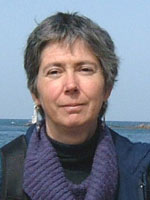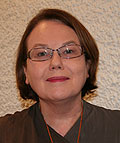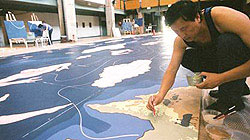Analysis
 |
NORTH KOREA AND JAPAN: REGIONAL DIPLOMACY AND HUMAN TRAGEDYby Tessa Morris-Suzuki tessa.morris-suzuki@anu.edu.au, Convenor and Professor of Japanese History, Division of Pacific and Asian History, Australian National University |
|
As Northeast Asia moves cautiously towards a resolution
of the North Korean nuclear issue, one group of people is watching the
negotiations quietly but with intense personal interest. Over the past
two years, I have been in touch with some of them. There is the woman
who has been campaigning for years to obtain permission for her sister,
now living in North Korea, to travel to Japan for one final meeting
with their frail and dying mother. Then there is the middle-aged woman
who lived for decades in North Korea but is now back in Japan, where
she was born, desperately worrying about the fate of the children and
siblings she has left behind. In 2004 I encountered a cache of newly-declassified documents which cast a disturbing light on this history. These reveal that the mass migration to North Korea, presented to the world as a “humanitarian repatriation”, was actually the result of a complex web of political dealings involving both Koreas, Japan, and the international Red Cross movement, with the Soviet Union providing support and the United States sometimes acting as intermediary. In the 1950s, around 600,000 Koreans lived in Japan, where they faced severe discrimination. From 1955, some influential Japanese politicians and bureaucrats |
developed a secret policy pushing for a mass migration of ethnic Koreans from Japan to North Korea. Knowing that this was a potentially explosive issue, they sought to ensure that the exodus was carried out under the auspices of the Red Cross. The North Korean government was contacted through its national Red Cross society. Meanwhile, Japan’s Ministry of Health and Welfare began slashing the limited welfare to which ethnic Koreans had access, thus making their lives in Japan more uncertain than ever. At first, North Korea had little interest in accepting an influx of Koreans from Japan. However, in 1958, its government – in the midst of a development plan for which labour was needed – issued a public welcome to “returnees” from Japan, who were promised housing, jobs, and welfare. A massive propaganda campaign swept through Japan’s Korean community. It was run by a pro-North Korean organisation, ably assisted by the Japanese media and members of Japan’s political elite. For most of the migrants, North Korea proved to be a place of great material hardship. For some, it was also a place of persecution and death. From the mid-1960s, North Korea began political repression of the “returnees”, who were regarded as “politically unreliable”. Unknown numbers, but certainly thousands, disappeared into prison camps.The recent Six-Party Talks between the two Koreas, the United States, China, Japan and Russia have highlighted the plight of Japanese citizens kidnapped by North Korea in the 1970s and 1980s; but the tragedy of the “returnees” to North Korea – this strange story which spans both sides of the Cold War divide – is still almost unknown. |
The current negotiations may enable the story of the
“returnees” to be heard, and may even offer hope that families
divided by this tragedy can someday be reunited. Links:
|

 |
'OTHER HISTORIES' AND CROSS-CULTURAL ENGAGEMENT IN ASIAN MUSEUMSby Caroline Turner caroline.turner@anu.edu.au, Senior Research Fellow in the Research School of Humanities Centre at the Australian National University |
|
Chinese Australian artist Guan Wei’s art installation Other Histories, curated by Claire Roberts for tPowerhouse Museum, Sydneyhe , poses an alternative Australian history, which some visitors may find challenging. Inspired by what the museum calls one of their most
‘mysterious objects’, a figure of the Chinese god of longevity
found in Northern Australia, Guan Wei suggests the possibility of a
pre-European Chinese discovery of Australia by Admiral Zheng He. Museums have a key role in preserving history. Today
they are also expected to engage with issues critical to the present
and even the hypotheses of ‘alternative history’, as evoked
so compellingly by Guan Wei. A particularly emotional issue has been Japan’s invasions of neighbouring countries in the 20th century. The Japanese National Museum of History still does not deal with the war, but recently held conferences on introducing the subject into displays and does treat the massacre of Koreans after the great Kanto earthquake of 1923. |
The National Museum of Ethnology (Minpaku) in Osaka was a pioneer in recognising the Ainu Indigenous people of Hokkaido as owners of the Ainu objects in their collections and as a living separate culture (many years before the Japanese Government did so).The curators have a continuing program to help establish Ainu museums in Hokkaido. The focus is on the revival of culture. The Osaka Government has supported the local community in creating the Liberty Museum dedicated to the history and human rights concerns of minorities, in particular the Buraku, ethnic Japanese descended from the lowest social group under the old feudal system. Tessa Morris –Suzuki has written eloquently on this Museum. In China the Shanghai Museum has become a leading museum in Asia for discussions about future museological directions. It hosted a major International Council of Museums (ICOM) international conference in 2002 on the |
subject of ‘intangible heritage’, meaning how to introduce the lives, customs, traditions, values and histories of the people who made exhibits, including the living histories of those who are the inheritors of that history. The conference also considered ways of approaching cultural diversity and minorities within societies in a museum context with recommendations set out in the ‘Shanghai Charter’ adopted by ICOM. ICOM Asia-Pacific is thus setting a new agenda for museological practice in the region, heralding perhaps a new approach to how the region understands its many histories and a step towards a shared set of values for museums in Asia.
Links: |

Profile
|
This month we profile Graeme Dobell,
Foreign Affairs/Defence correspondent in Canberra for Radio Australia,
the international service of the Australian Broadcasting Corporation.
www.abc.net.au/ra/ |
||
|
I started work in as a journalist in 1971 on the Melbourne broadsheet afternoon paper, The Herald (moving from copy boy, to cadet to graded journalist). The key shift for me was moving to Radio Australia (RA) as a current affairs reporter in 1975, just after Saigon fell, just before Indonesia invaded East Timor (and before Gough fell as well). It was quite a year, and I’ve been studying Asia pretty well full time ever since. Radio Australia’s target audiences are East Asia and the South Pacific and that has been my focus. I’m a tribute to lack of career progression really. I first came to Canberra to be RA’s correspondent in 1978 and I keep coming back to this position from various overseas postings. Q: What are your current preoccupations?
|
What I write about here in Canberra is often very similar to the stuff I was covering when I was based in Singapore as the ABC’s Southeast Asia correspondent. Q: How do these fit into the contemporary scene? Links:
|
|

Student of the month
| Rebecca Livermore rl2@postoffice.utas.edu.au,
Her first experience in Asia, indeed anywhere outside Australia, was a family holiday to Bali when she was 12. The family travelled around Bali for five weeks, to Kuta, Ubud, Padangbai, Gili Meno, Lombok and some very secluded villages. Rebecca was fascinated by the culture, especially the role of Hinduism and Islam in people’s lives. |
The Indonesian people, especially in the smaller villages, were very friendly and caring, always smiling and joking, and the families who hosted the Livermores were as interested in hearing about Australia as they were to learn about Indonesia. That time in Bali made a lasting impression. When Rebecca started uni she decided to study Indonesian. After completing her first year of a Bachelor of Arts, she spent a month in Yogyakarta studying at Realia, an Indonesian language school, which gave her credit towards her degree. At the end of her second year she applied to take part in the first course offered in English to foreign students by the Universitas Islam Indonesia (UII). Rebecca is entering her sixth week of study at UII. At first it was a bit daunting being the only female student not wearing a ‘jilbab’ (headscarf) but the students and staff have made her feel very welcome and she’s enjoying the experience immensely. Her subjects are Islamic Religious Practice, Islamic Leadership, Indonesian Business Practice, Islamic Thought and Civilisation and Islamic Macroeconomics. All are giving Rebecca an insight into the way in which Islam influences the lifestyle and thinking of the Islamic people in Indonesia. It is a unique experience to learn about Indonesian life and religion first hand, something it is impossible to do out of a text book or in a classroom in Australia. Rebecca aims to work on relations between Indonesia and Australia in the future, hoping that her knowledge and friendships will help to diminish the tensions between the two countries, most of which she ascribes to suspicion and ignorance. |

Website of the month
|
The World Wide Web Virtual Library - Malaysia, is a collection of links and other online resources related to Malaysia. It has recently been revamped and now has an enlarged news section. The website is part of a global collaborative project which provides access to networked scholarly documents, resources and information systems concerned with or relevant to Asian Studies.The Asian Legal Information Institute is a gateway that allows simultaneous searching of more than 100 databases containing legislation, case-law, law reform reports and legal journals from 27 countries including the Philippines, Indonesia, Japan, Pakistan, Mongolia and East Timor. |
Recent article of interest
|
History in Uniform: Military Ideology and the Construction of Indonesia's Past by Katharine McGregor. Under the New Order regime (1967–98), the Indonesian military sought to monopolise the production of official history. The goal was to validate the political role of the armed forces, condemn communism and promote military values. In this detailed examination of the Indonesian military’s image-making efforts, McGregor explores the formulation of nationalist history under Suharto, and shows how this affected the Indonesian people. NUS Press, February 2007, 288pp. See http://www.unireps.com.au. Note: ASAA members can get a discount on this book. http://www.unireps.com.au/isbn/9971693607specd.htm |

Did you know?
| The Lowy Institute for International Policy has launched its fifth program, the West Asia program, incorporating the Middle East and South Asia. It is focused on seven key themes – the role of the US in these regions, terrorism, energy security, the rise of new powers, notably India, proliferation, Islam and democratisation. To coincide with the launch, the West Asia Program Director Anthony Bubalo has published a new policy brief which argues why the Middle East and South Asia should increasingly be viewed as a single region in strategic terms, and explores the policy implications of such a perspective for Australia. See http://www.lowyinstitute.org/Publication.asp?pid=543 |

Diary dates
|
TIES THAT BIND:
WEAVERS, CLOTH, AND SOCIETY IN FLORES, INDONESIA 27 March 2007, Sydney.
As part of the Australian Centre for Asian Art and Archaeology Seminar
Series at the University of Sydney, Dr Roy Hamilton, Senior Museum Scientist
(Curator, Asian & Pacific Collections), Fowler Museum of Cultural
History, University of California, will discuss the role of cloth on
the Indonesian island of Flores. 4.00 pm – 5.30 pm, Room 202,
R.C. Mills Building, Fisher Road, University of Sydney. See http://db.auth.usyd.edu.au/directories/map/ GLOBAL SECURITY ASIA 2007, 27-29 March 2007, Singapore. Global Security Asia 2007 www.globalsecasia.com will be a forum for the international homeland security industry to showcase their latest equipment, systems and services in order to meet the current and future demands in the Asia Pacific region. Austrade will coordinate an Australian National Stand at this exhibition and offers a business and support services to participants. Contact Christopher Soh, Senior Business Development Manager, Austrade Singapore, christopher.soh@austrade.gov.au SHANGHAI ART FAIR 2007 - Free Information Seminars, Sydney, Melbourne, Adelaide, Brisbane, during April. The Shanghai Art Fair is China’s largest art show. Austrade is offering Australian art galleries, artists and representatives space in an exclusive Australian Art Showcase in 2007. Register online http://www.austrade.gov.au/Shanghai-Art-Fair-Info-Seminars/default.aspx or call Austrade Direct on 13 28 78 email: info@austrade.gov.au DISSECTING DISSECTION IN LATE IMPERIAL AND EARLY MODERN CHINA: LU XUN'S ANATOMICAL AESTHETICS, 24 April, Sydney. Dr Larissa Heinrich, Lecturer in Chinese Studies, Department of Chinese and Indonesian Studies, UNSW, presents this seminar in the Australian Centre for Asian Art and Archaeology Seminar Series at the University of Sydney. For further information contact Gabrielle Ewington: acaaa@arts.usyd.edu.au SOUTH ASIA ENGAGED, 27-29 April 2007, Los Angeles. The South Asian Studies Alliance is hosting its foundation conference with a focus on how South Asia is being integrated into the world. The proposal deadline is 18 February 2007. See http://sasia.org CHINESE STUDIES ASSOCIATION OF AUSTRALIA, 10th Biennial Conference, 27-29 June 2007, Brisbane. Griffith University, will be hosting the conference at Southbank in Brisbane. Watch the website for details: http://www.csaa.org.au/news.html |
2ND ASIAN AUSTRALIAN IDENTITIES conference, 28-30 June 2007, Melbourne. The organisers welcome papers and presentations exploring Asian Australian identities, histories, cultures and politics. All presentations should be of 20 minutes duration. Abstracts (max 200 words) and a short bio (max 200 words) should be sent to admin@asianaustralianstudies.org or contact the convenors, tseen.khoo@arts.monash.edu.au or jacqueline.lo@anu.edu.au CHINA EAST ASIA MEDIA/NEW MEDIA CONFERENCE,
5-6 July, Brisbane. China’s emergence as a manufacturing
behemoth is reshaping the global economy. However, China’s media
and creative industries have not achieved the same export oriented momentum
as its low cost manufacturers. With the Beijing Olympics moving closer
China is mounting a claim for a leading role in the global and regional
cultural economy, drawing on its long tradition as the centre of East
Asian culture. Will this be vision ever be achieved? The conference
will be hosted by the Australian Research Council Centre of Excellence
for Creative Industries and Innovation http://www.cci.edu.au
IN SEARCH OF RECONCILIATION AND PEACE IN INDONESIA, workshop 19 and 20 July 2007, Singapore. The Indonesia Study Group, Asia Research Institute, National University of Singapore is holding an interdisciplinary workshop to examine approaches to reconciliation and peace in Indonesia. Its aim is to provide insights into ways forward not only for Indonesia, but for conflict situations much more broadly. http://www.ari.nus.edu.sg or contact the convenor, Dr Birgit Bräuchler aribb@nus.edu.sg CHINA: Conference on Migration and Social Protection,
25 to 26 September, Beijing. Monash University's Asian Business
and Economics Research Unit together with the Institute of Population
and Labour Economics at the Chinese Academy of Social Sciences and the
Renmin-Monash Advanced Centre for Economic Studies are staging an international
conference to explore issues such as: labour market integration and
social protection, migrant participation in social security schemes,
migrant alternatives to state-sponsored social protection, migrant working
conditions, salaries and wage arrears, and responsibilities of government
in the provision of social protection. See www.buseco.monash.edu.au/units/aberu/ |

You are welcome to advertise Asia-related events in this space. Send details to: fbeddie@ozemail.com.au
Feedback
What would be useful for you? Human interest stories, profiles of successful graduates of Asian studies, more news about what's on, moderated discussions on topical issues? Send your ideas to fbeddie@ozemail.com.au.
About the ASAA
The Asian Studies Association of Australia (ASAA) promotes
the study of Asian languages, societies, cultures, and politics in Australia,
supports teaching and research in Asian studies and works towards an understanding
of Asia in the community at large. It publishes the Asian Studies Review
journal and holds a biennial conference. ASAA and the Centre for Language
Studies at National University of Singapore also co-publish an annual supplementary
issue of the Centre's fully peer-reviewed electronic Foreign Language Teaching
Journal (e-FLT). See http://e-flt.nus.edu.sg
The ASAA believes there is an urgent need to develop a strategy to preserve,
renew and extend Australian expertise about Asia. It has called on the government
to show national leadership in the promotion of Australia’s Asia knowledge
and skills. See Maximizing Australia's Asia Knowledge Repositioning and
Renewal of a National Asset http://coombs.anu.edu.au/SpecialProj/ASAA/asia-knowledge-book-v70.pdf
Asian Currents is published by the Asian Studies Association of Australia (ASAA) http://coombs.anu.edu.au/ASAA/ thanks to a grant from the International Centre of Excellence for Asia Pacific Studies (ICEAPS) http://iceaps.anu.edu.au. It is edited by Francesca Beddie. The editorial board consists of Robert Cribb, ASAA President, Michele Ford, ASAA Secretary, Mina Roces, ASAA Publications officer, Tamara Jacka, ASAA Council member, and Ann Kumar, Director, ICEAPS.


 Q:
When did you become interested in studying Asia and why?
Q:
When did you become interested in studying Asia and why?  an
undergraduate at the University of Tasmania, is spending this semester
at the Universitas Islam Indonesia (Indonesian Islamic University) in
Yogyakarta, as part of the ACICIS www.acicis.murdoch.edu.au Indonesian
in-country program. Rebecca received a $2000 scholarship from the Australian
government to help her with her travels and study.
an
undergraduate at the University of Tasmania, is spending this semester
at the Universitas Islam Indonesia (Indonesian Islamic University) in
Yogyakarta, as part of the ACICIS www.acicis.murdoch.edu.au Indonesian
in-country program. Rebecca received a $2000 scholarship from the Australian
government to help her with her travels and study.